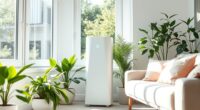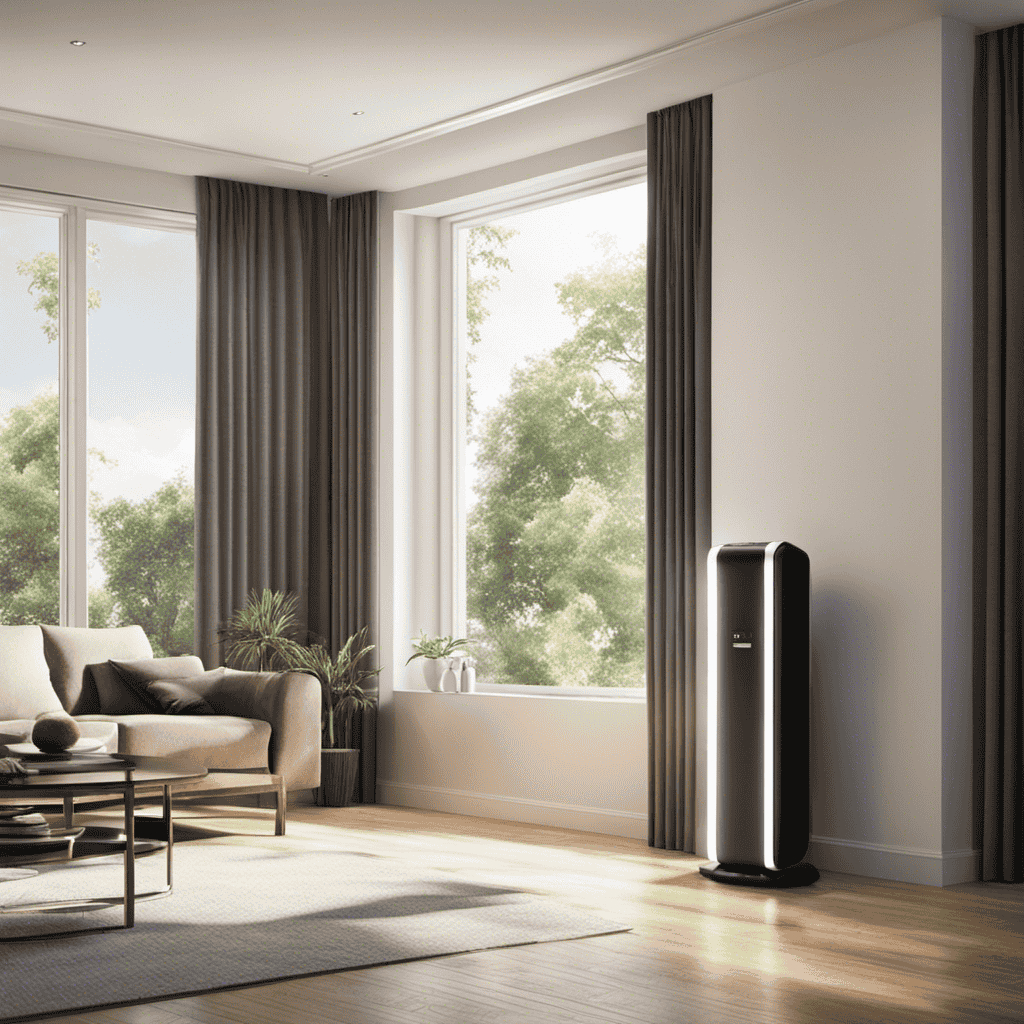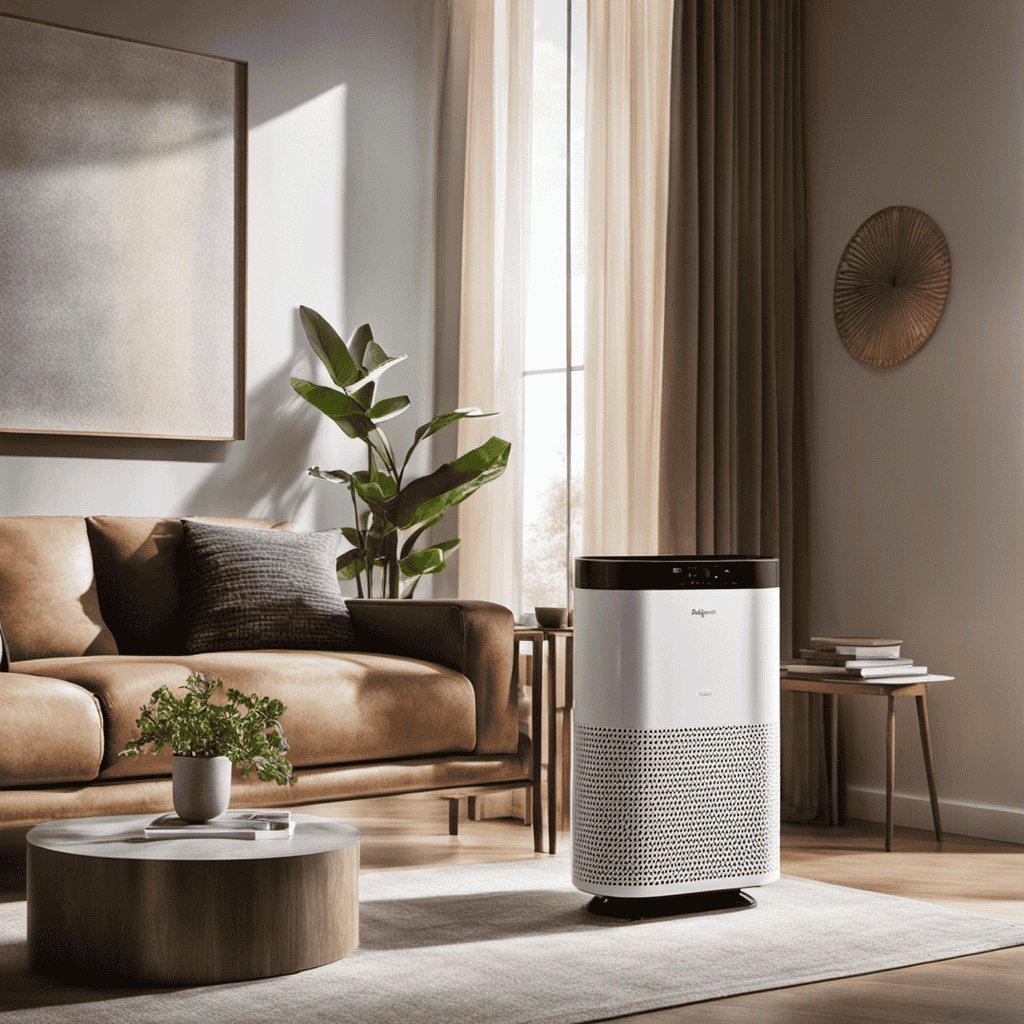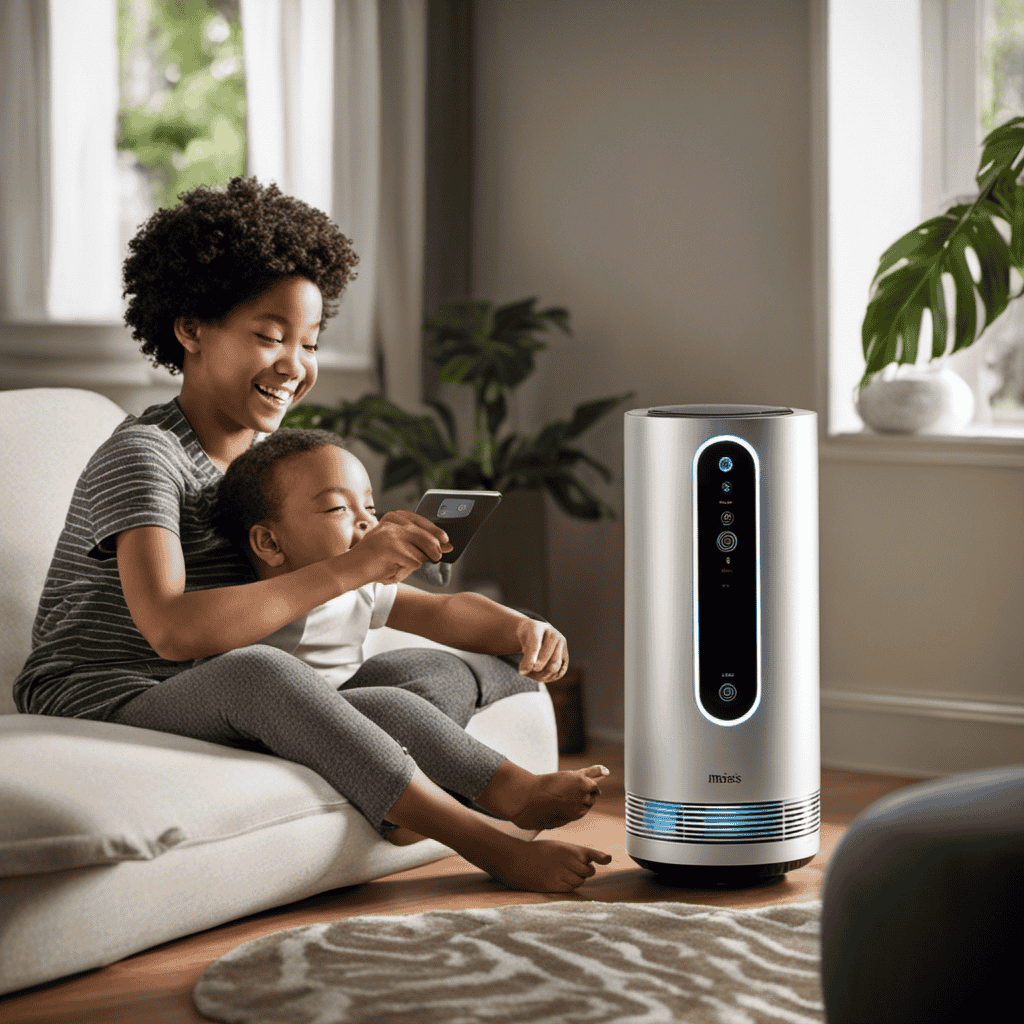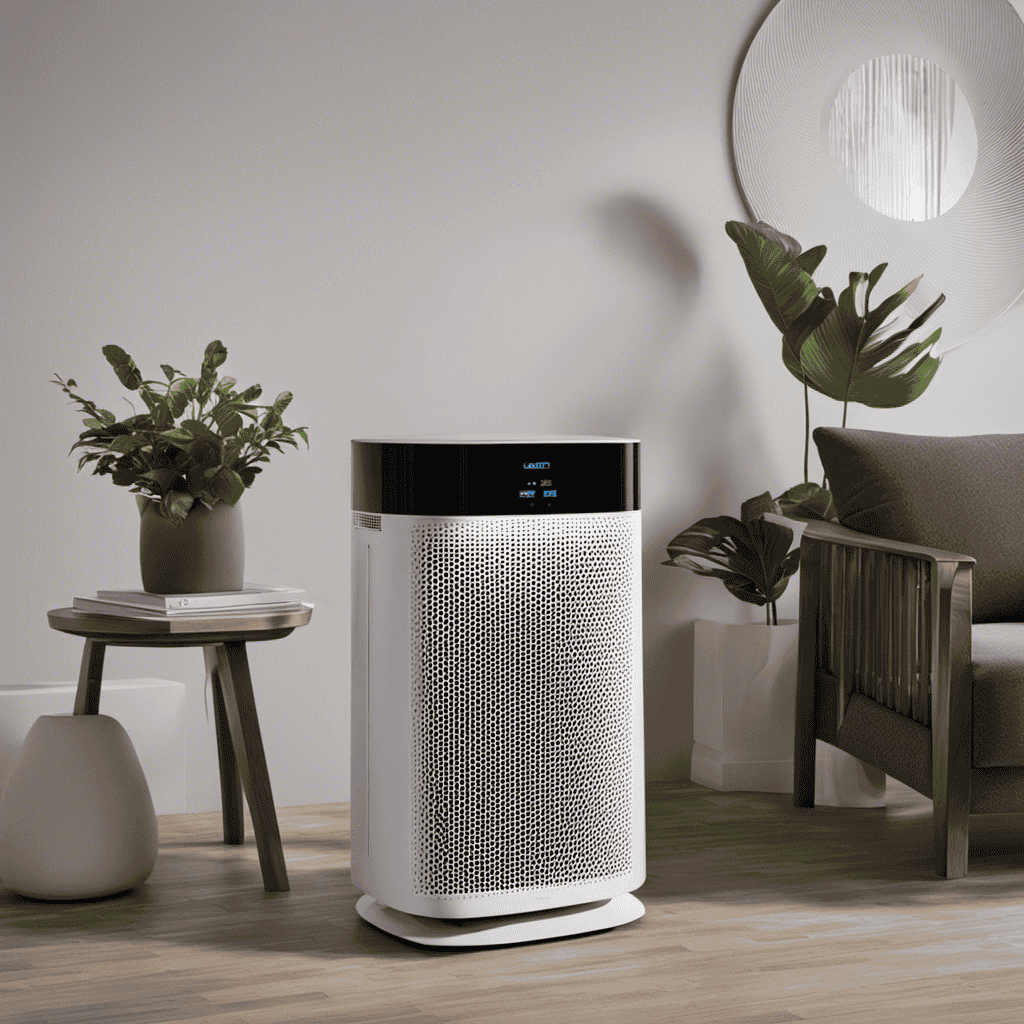Air purifiers can be safe for babies when you choose models with proper certifications, such as HEPA filters, and safety features that prevent ozone emissions or excessive noise. It’s important to select a purifier designed for baby rooms, keep it at a safe distance from your child’s sleeping area, and follow maintenance instructions. Proper use guarantees cleaner air without risks. To find out more about making the right choice for your little one, continue exploring credible advice.
Key Takeaways
- Choose baby-safe, certified air purifiers with HEPA filters and no ozone emission.
- Avoid units with high noise levels to prevent sleep disturbances for infants.
- Regularly maintain and replace filters to prevent bacteria or mold growth.
- Place purifiers away from the baby’s sleeping area to ensure safety and proper airflow.
- Use natural ventilation and indoor plants as complementary methods for safer air quality.
Understanding How Air Purifiers Work and Their Types
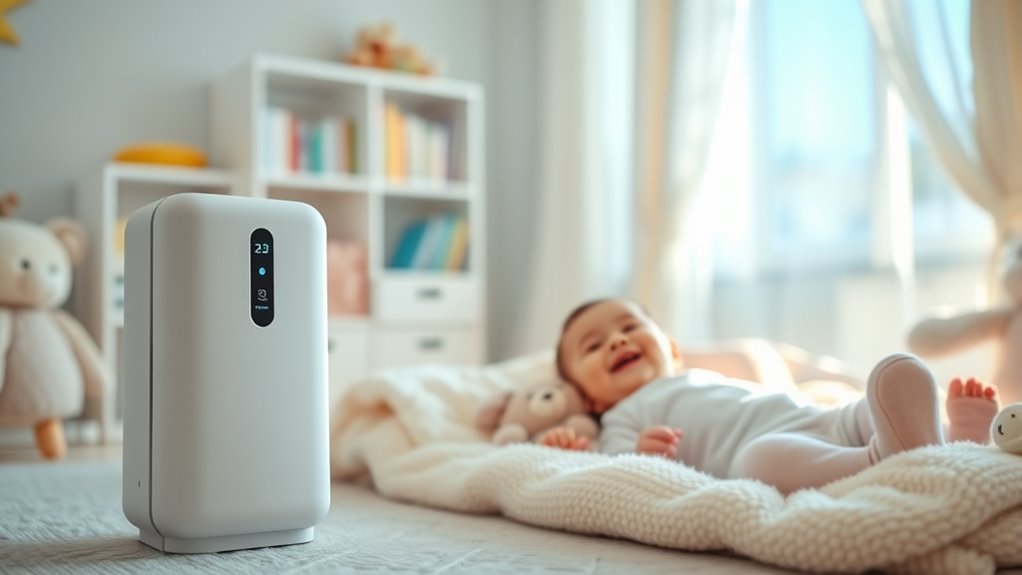
Air purifiers work by removing harmful particles and pollutants from the air to create a safer environment, especially for babies. Most models use HEPA filters, which capture tiny particles like dust, pollen, pet dander, and bacteria with high efficiency. These filters trap allergens that can affect your baby’s breathing. Some air purifiers also include activated carbon filters, which absorb odors, gases, and volatile organic compounds (VOCs), improving indoor air quality. Depending on the type, air purifiers may use fans to circulate air through these filters continuously. Compact or portable designs are common for home use, while larger units are suitable for bigger spaces. Understanding the differences between HEPA and activated carbon filters helps you choose the right device to protect your little one. HEPA filters are especially effective at capturing microscopic particles, making them a popular choice for creating a cleaner indoor environment. Additionally, advancements in AI security contribute to the development of smarter, more reliable air purification systems that can adapt to changing air quality conditions. Modern systems can also incorporate sensor technology that monitors air quality in real time to optimize purification cycles. Proper maintenance and selecting models with filter indicators can further ensure your baby’s environment remains healthy and safe.
Potential Benefits of Using Air Purifiers for Infants
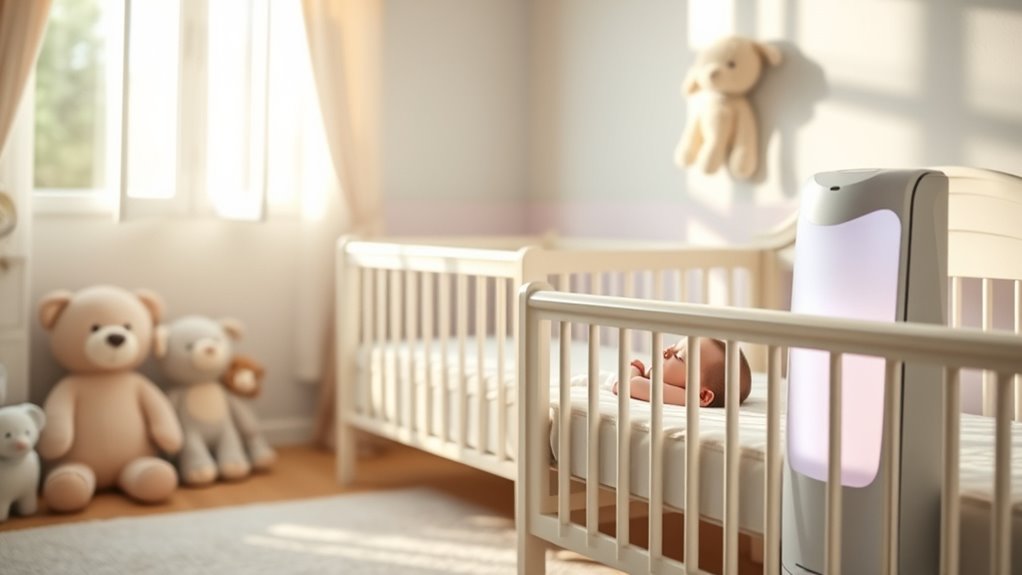
Using air purifiers can substantially reduce your baby’s exposure to allergens, pollutants, and airborne irritants, helping to create a healthier indoor environment. HEPA filters are highly effective at capturing tiny particles like dust, pet dander, and pollen, which can trigger allergies or respiratory issues. UV sterilization adds an extra layer of protection by neutralizing bacteria, viruses, and mold spores present in the air. Together, these features help improve air quality, potentially reducing your baby’s chances of developing asthma or respiratory infections. By maintaining cleaner air, your baby can breathe more easily and sleep more soundly. While no device guarantees complete safety, choosing an air purifier with HEPA filters and UV sterilization can offer notable benefits for your infant’s health. Additionally, incorporating air quality monitoring can help you keep track of indoor pollution levels to ensure a safe environment. Recent AI discoveries have also shown that nanobots can be used to actively remove airborne contaminants, which may further enhance air purification technology in the future. Advances in filtration technology continue to improve how effectively these devices can clean indoor air, providing even better protection for your family. Understanding industry trends can help you choose the most effective and up-to-date air purification solutions for your home.
Common Concerns and Safety Risks for Babies
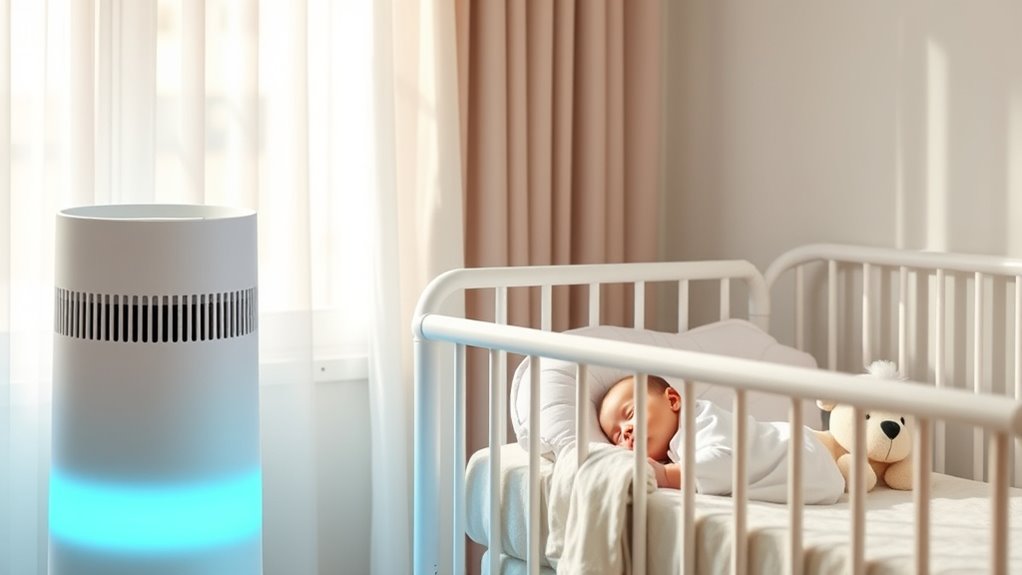
While air purifiers can improve indoor air quality, parents should be aware of potential safety concerns for their babies. Some air purifier myths suggest they’re completely risk-free, but improper use or certain models can pose hazards. For example, noisy units may disturb your baby’s sleep, and poorly maintained devices can circulate bacteria or mold. Additionally, some purifiers produce ozone, which can irritate your baby’s lungs. While allergy relief is a benefit, not all purifiers are suitable for infants. Always check the product’s safety features and certifications. Be cautious of:
- Ozone-emitting purifiers
- Noisy units disrupting sleep
- Poor maintenance leading to mold
- Sharp or loose parts
- Overly strong air flow causing discomfort
Understanding the role of proper maintenance in preventing bacterial growth is crucial for safe device operation. Proper cleaning and filter replacement can significantly reduce health risks associated with air purifier bacteria. Knowing these risks helps ensure your baby’s safety while enjoying cleaner air, especially when choosing vetting effective and safe devices.
Choosing the Right Air Purifier for Your Child’s Room

When selecting an air purifier, you need to consider the filter type to ensure it’s safe and effective for your child. Make sure it matches the room size so it can clean the air efficiently without being overpowering. Also, check the noise levels to keep the environment comfortable and conducive to your baby’s rest. Additionally, choosing a model with HEPA filtration can help effectively remove airborne allergens and pollutants, providing a healthier environment for your baby. A dual-filter system can further enhance purification by capturing a broader range of contaminants. When evaluating models, pay attention to specialized features that cater to sensitive environments, ensuring the purifier is suitable for your child’s room. Opting for models with low noise operation ensures the purifier won’t disturb your child’s sleep or daily activities.
Filter Types and Safety
Choosing the right air purifier for your child’s room starts with understanding the various filter types and their safety features. HEPA filters are vital because they trap tiny particles like dust, allergens, and bacteria, providing cleaner air. Activated carbon filters absorb odors, chemicals, and VOCs, making the environment safer for your baby. When selecting a filter, verify it’s certified and free from harmful chemicals. Look for filters that are easy to replace and don’t release particles back into the air. Safety features like sealed units prevent leaks, and filters made from non-toxic materials are essential. Additionally, selecting a device with proper filtration ensures that harmful pollutants are effectively removed without compromising safety. Considering the filter maintenance requirements can also impact the ongoing safety and performance of the air purifier.
Room Size Compatibility
Selecting an air purifier that matches the size of your child’s room guarantees it effectively cleans the air without wasting energy. When choosing, consider room size compatibility to guarantee optimal performance. An undersized purifier may struggle to clean the air properly, while an oversized one could be unnecessarily loud and costly. Proper air purifier placement is also vital; position it in a central location away from walls and furniture for maximum efficiency. Use the table below to help determine the right size:
| Room Size (sq ft) | Recommended Air Purifier Capacity (CFM) |
|---|---|
| 100-200 | 4-6 CFM |
| 200-400 | 6-10 CFM |
| 400+ | 10+ CFM |
Matching your purifier to your child’s room size ensures a safe, effective air-cleaning environment. Proper placement and selecting the right capacity are both crucial elements in ensuring your air purifier performs at its best. Ensuring that your air purifier’s airflow matches the room size can significantly improve its effectiveness and longevity. Additionally, choosing a model with appropriate filtration features can contribute to a healthier indoor environment for your child. Incorporating high-quality filters can further enhance air purification efficiency and reduce allergens. Being aware of headphone safety is also important if your child uses headphones with the purifier running nearby.
Noise Levels and Comfort
Since noise can disturb your child’s sleep and daily comfort, it’s essential to evaluate the sound levels of an air purifier before making a purchase. Look for models with low noise levels to ensure a peaceful environment. Prioritize devices with effective noise reduction features to minimize disruptions. Consider the following when choosing:
- Decibel ratings (aim for 25-30 dB for quiet operation)
- Sleep mode options for ultra-quiet operation
- Fan speed settings for adjustable noise levels
- Sound insulation or muffling technology
- User reviews on noise reduction performance
- Be aware that AI-powered virtual reality in e-learning can be used to simulate a quiet environment for testing noise levels.
Important Safety Features to Look For
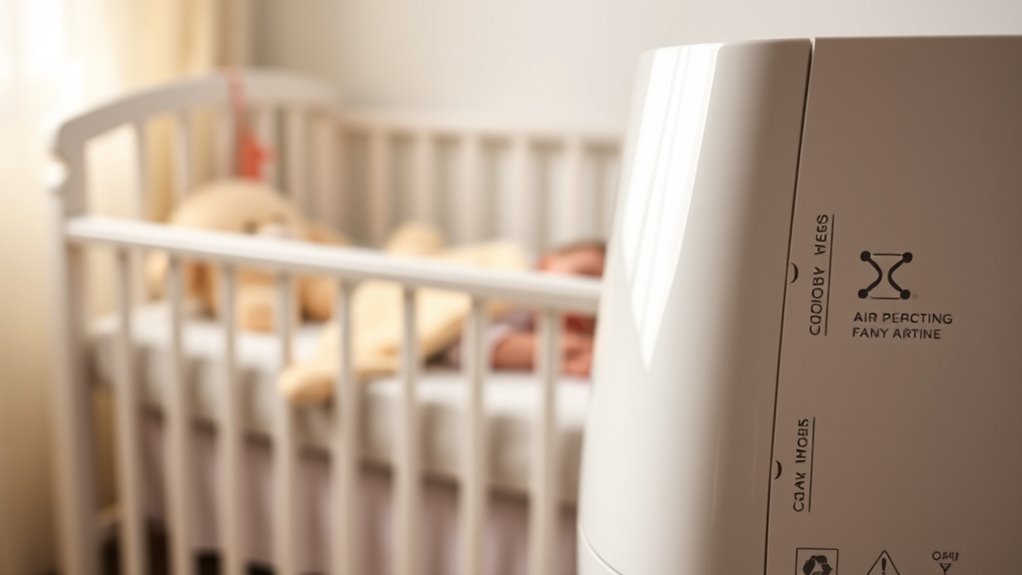
When shopping for an air purifier for your baby, prioritizing safety features is vital to guarantee a secure environment. Don’t fall for air purifier myths that suggest all models are equally safe; instead, look for features like automatic shut-off, child-proof locks, and filter indicators. These ensure the device operates safely and efficiently, reducing risks. Additionally, choose purifiers with certified HEPA filters that effectively aid allergy reduction without releasing harmful byproducts. Avoid models with ozone generators or ionizers, as these can produce pollutants harmful to your baby’s lungs. Safety features like stable bases and quiet operation also contribute to a safer, more comfortable space. By focusing on these key safety aspects, you protect your little one while enjoying the benefits of cleaner air. Staying informed about legislative changes related to air purifier safety can help you make better purchasing decisions. Incorporating filter indicators helps monitor filter life and maintain optimal performance, ensuring continued safety and efficiency. Being aware of regulatory standards can also guide you toward safer, more reliable models. Regularly checking for product recalls ensures the device remains safe for your baby over time. Moreover, considering certified filters guarantees that the air purifier meets established safety and performance benchmarks.
Proper Usage and Maintenance of Air Purifiers
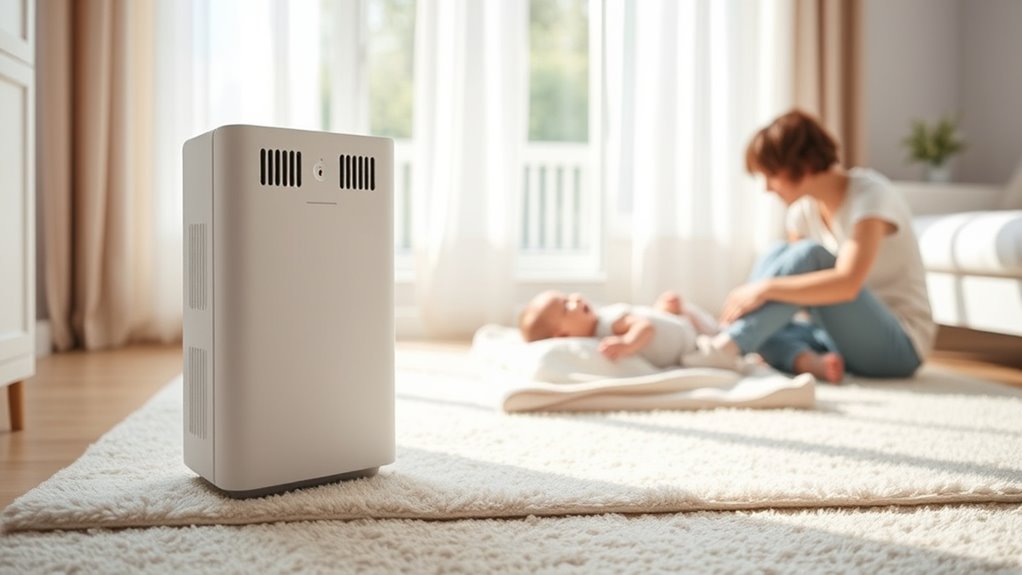
To guarantee your air purifier works effectively and remains safe for your baby, proper usage and regular maintenance are essential. You should follow the manufacturer’s instructions for setup and operation, avoiding overuse or incorrect placement. Keep up with regular air purifier maintenance to maximize performance. This includes adhering to filter replacement schedules, as dirty filters reduce efficiency and may release pollutants. Always turn off and unplug the device before cleaning or servicing it. Check filters monthly and replace them as recommended. Keep the air purifier in a central location, away from walls or obstructions, to optimize airflow. Regularly clean the exterior to prevent dust buildup. Proper maintenance ensures your purifier works safely, providing cleaner indoor air for your baby. Additionally, understanding the importance of necessary cookies can help ensure optimal device functionality and security.
Alternatives to Air Purifiers for Ensuring Indoor Air Quality

You can improve indoor air quality without an air purifier by increasing ventilation through open windows and vents. Adding indoor plants can naturally filter the air, while regular cleaning helps remove dust and allergens. These simple steps make a noticeable difference in creating a healthier environment for your baby.
Improve Ventilation Naturally
Improving indoor air quality naturally involves increasing ventilation to let fresh air circulate and dilute pollutants. Natural ventilation is a simple way to achieve this. By opening windows and doors regularly, you encourage air circulation, reducing indoor pollutant levels. Cross-ventilation, where air flows from one side of your home to the other, is especially effective. You can also use exhaust fans in kitchens and bathrooms to remove moisture and odors. Ensuring good airflow helps keep indoor air fresh and healthy for your baby.
- Open windows daily for fresh air
- Use cross-ventilation strategies
- Keep exhaust fans running regularly
- Avoid blocking vents and airways
- Create airflow by adjusting window placement
Use Indoor Plants Effectively
Indoor plants can serve as natural air purifiers, complementing good ventilation practices to enhance your home’s air quality. Unlike air purifier technology, which filters indoor air pollutants with machines, plants absorb certain toxins through their leaves and roots, helping reduce harmful substances like formaldehyde and benzene. To use indoor plants effectively, choose varieties known for their air-cleaning properties, such as snake plants, pothos, or peace lilies. Place them in areas with good natural light and avoid overwatering, which can promote mold growth. While plants do improve indoor air quality, they work best alongside other strategies like proper ventilation. Keep in mind, plants alone can’t eliminate all indoor air pollutants but can be a natural and aesthetic addition to your efforts to create a healthier environment for your baby.
Regular Indoor Cleaning
Regular cleaning of your home surfaces plays an essential role in maintaining good indoor air quality without relying solely on air purifiers. It helps combat common air purifier myths that suggest they’re the only solution for allergen reduction. By regularly dusting, vacuuming with a HEPA filter, and wiping down surfaces, you remove dust, pet dander, mold spores, and other allergens that can affect your baby’s health. These practices prevent buildup and improve air quality naturally.
- Vacuum with a HEPA filter regularly
- Dust surfaces weekly
- Wash bedding and curtains often
- Keep mold growth in check
- Avoid clutter that traps dust
Tips for Creating a Safe and Healthy Environment for Your Baby
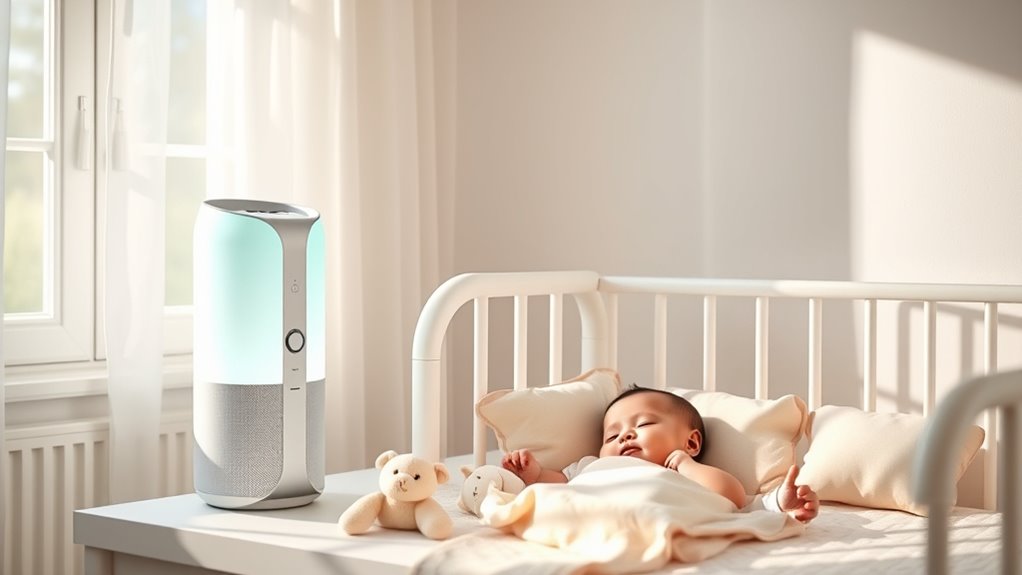
Creating a safe and healthy environment for your baby starts with paying close attention to the air they breathe. First, don’t fall for air purifier myths that all models are unsafe; instead, look for baby safe models designed specifically to filter out allergens and pollutants without emitting harmful substances. Always choose air purifiers with certified HEPA filters, which effectively trap airborne particles. Keep the purifier in a central location where it can circulate clean air throughout the room. Regularly maintain and change filters to ensure ideal performance. Avoid devices with unnecessary features or fragrances that could irritate your baby’s sensitive lungs. By selecting the right model and maintaining it properly, you create a safer, healthier space where your baby can thrive.
Frequently Asked Questions
Can Air Purifiers Cause Allergies or Respiratory Issues in Babies?
You might wonder if air purifiers cause allergies or respiratory issues in babies. Proper air purifier maintenance is vital to guarantee allergen filtration efficiency, preventing the release of dust or mold spores. If filters aren’t regularly changed, it could lead to allergens circulating, potentially irritating your baby’s lungs. Choosing a purifier suited for a nursery and maintaining it well helps reduce risks, keeping the air clean and safe for your little one.
Are There Specific Air Purifier Brands Recommended for Infants?
Think of choosing an air purifier for your baby as selecting a gentle guardian for their tiny world. Look for models with specific air purifier features like quiet operation and safe filters designed for infants. Baby safe filters trap harmful particles without releasing harmful substances. Brands like Honeywell, Blueair, and Winix often include these features, making them reliable choices. Always double-check that the purifier’s features prioritize your baby’s health and safety.
How Loud Are Typical Air Purifiers Around a Sleeping Baby?
You might wonder about the noise levels of air purifiers around a sleeping baby. Most modern units operate quietly, producing noise levels that won’t disrupt sleep. Look for models labeled as “quiet” or “sleep mode,” which typically emit gentle white noise that can even help your baby sleep better. However, it’s good to monitor your baby’s response, as overly loud purifiers could cause sleep disruption.
Do Air Purifiers Emit Harmful Ozone or Chemicals?
Think of air purifiers as gentle guardians, but some can secretly emit ozone emissions that act like invisible smoke, risking chemical exposure. These harmful byproducts can irritate your baby’s delicate lungs or trigger allergies. To keep your little one safe, choose models that specify low or no ozone emissions and avoid those with strong chemical fragrances. Your vigilance makes certain of a safe, fresh environment where your baby can breathe easy and grow happily.
How Often Should an Air Purifier Be Replaced or Serviced for Baby Safety?
You should replace filters and follow the maintenance schedule recommended by the manufacturer, typically every 6 to 12 months, to keep your air purifier running safely. Regular filter replacement ensures it effectively removes pollutants without releasing harmful particles or ozone. Check your device’s manual for specific guidance, and clean or replace filters promptly to maintain ideal air quality, especially for your baby’s safety.
Conclusion
When it comes to your baby’s safety, choosing the right air purifier is like tuning a delicate instrument—every feature matters. With proper care and mindful selection, you create a haven where fresh air dances freely, shielding your little one from unseen threats. Remember, it’s not just about filtering air but nurturing a safe, healthy environment where your baby can breathe easy and thrive, turning every breath into a gentle lullaby of well-being.

